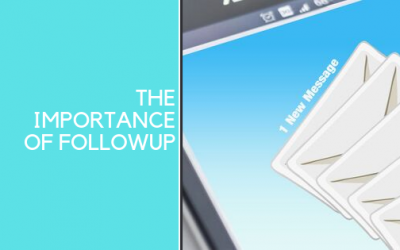What if I told you that only 2% of sales occur on the first contact? And that it’s typically only because the client did research and had already made the decision to buy?
Crazy, right?
There’s a famous saying that goes, “There’s fortune in the follow-up” and they’re right.
Research says that 44% of people give up after hearing the first “no”.
22% after the second “no”
14% after the third
12% after the fourth
It takes, on average, 5 follow-ups to get a yes. Sometimes even up to 12. Nearly 80% of all sales are made on the 5th through 12th follow-up.
That means that 8% of people are making 80% of the sales. Wild.

So if that’s the case, why don’t people follow-up?
They feel like they’re being annoying or overbearing. They think the people won’t respond after a second or third email (They probably won’t). Or they simply don’t want to hear the word “no”.
It’s very important to be persistent when it comes to closing a sale or getting a contract signed, and the same can be said when you’re networking to find a job. People are busy and life happens. Sometimes your email gets lost in the madness that can be someone’s inbox. Sending that follow-up moves your email back up to the top and to the front of their mind.
Want to know how to follow-up while avoiding looking pushy or irritating? Of course, you do.
Follow Up with a Valid Business Reason.
A valid business reason is pretty much what it sounds like. It’s a reason to contact them based on something that happened either in their business or their industry. Is there new legislation that affects their company? Did their business win an award? Simply finding something that has to do with them or their company can give you a reason to shoot them an email.
Pro tip: set up a Google Alert with their company name.

Do Your Research
It’s a good idea to do some research on the person you’re reaching out to in order to gain context on what they are working on or things they’re interested in. In fact, studies by Search Engine Land have shown that 86% of top sellers always research prospects before reaching out. It helps to make them the best!
Try connecting on LinkedIn. Find ways to comment on what they’re posting. Liking their posts and adding your opinions to articles they share are ways to get your name in front of them. Everyone loves a compliment and it compels them to keep reading, so why not share a little professional love? Each interaction is a form of followup and keeps you in the front of their mind.

Remember this quote from Maxwell:
“People don’t care how much you know until they know how much you care.” – John C. Maxwell
Have you ever received an email that you just KNOW is a generic, one-size-fits-all sort of thing? Like maybe it was written by a robot and the subject line is so boring, you just delete it without even opening it? I have, you have, we ALL have. Don’t be that guy. When you’re following up via email, it’s important to give context in the subject line, and this important piece of real estate is a great way to encourage readers to open your email. YOU know why you’re emailing, but that doesn’t mean they do. People are busy and get a lot of emails. Show that you care about what’s going on in their life or their business and use that knowledge to create an enticing subject line.

Always do your best to follow up. It’s essential to be persistent, but you don’t have to be annoying or pesky. If you stay polite, do a little research, actually send a follow-up email, and are unafraid of hearing “no”, you’re much more likely to make the connection! People genuinely want to help and will more likely reward your persistence if you are consistent. Remember, if they don’t have a position for you, they probably know someone who might!
If you’ve sent, what feels like, a million follow up messsages and you still haven’t received a response, you may be feeling like you’re ready to quit. This will happen. What do you do? When is enough, enough?
A good way to let a potential contact know you’re not going to reach out anymore is to send them a “breakup” email. It’s literally an email stating that you have tried multiple times to get in touch and since you haven’t heard back, you’re going to stop contacting them.
“Breakup” or “goodbye” emails are a great way to get a response. Some studies suggest that these types of emails receive a 33% response rate. People don’t like to think that they missed out on something. But guess what? Even these breakup messages are another form of… you guessed it! Follow up!

If you’re stuck and you don’t know a good follow up sequence, we’re here to help! Here at Optimized Career Solutions, we specialize in Career Success. With our 1 on 1 coaching, we help you craft you build your network and craft your follow up messages. We also encourage you to keep going when you feel like you just can’t send one more message! Our proven sequence of followup messages has successfully landed interviews from cold messaging. We believe in the power of followup and are here to help you become a believer too. To find out more about our career success services, click here!

